Risk and Benefits of ACE Inhibitor and Calcium Channel Blocker in Hypertension Treatment
VerifiedAdded on 2023/06/15
|9
|2571
|238
AI Summary
This essay discusses the benefits, risks and treatment outcomes of ACE inhibitors and calcium channel blockers in hypertensive patients. It covers the recommended patients for each treatment option and their contraindications.
Contribute Materials
Your contribution can guide someone’s learning journey. Share your
documents today.
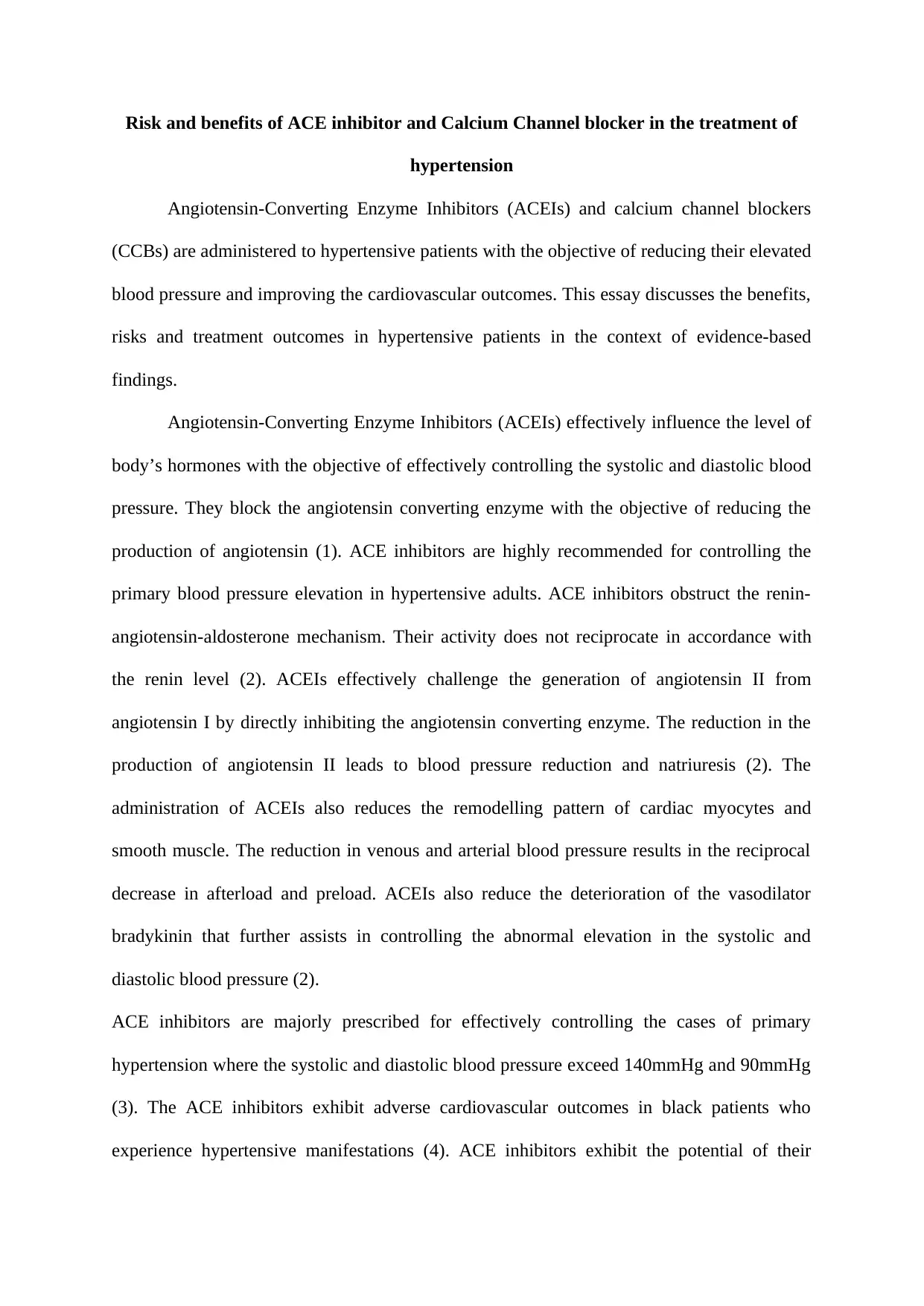
Risk and benefits of ACE inhibitor and Calcium Channel blocker in the treatment of
hypertension
Angiotensin-Converting Enzyme Inhibitors (ACEIs) and calcium channel blockers
(CCBs) are administered to hypertensive patients with the objective of reducing their elevated
blood pressure and improving the cardiovascular outcomes. This essay discusses the benefits,
risks and treatment outcomes in hypertensive patients in the context of evidence-based
findings.
Angiotensin-Converting Enzyme Inhibitors (ACEIs) effectively influence the level of
body’s hormones with the objective of effectively controlling the systolic and diastolic blood
pressure. They block the angiotensin converting enzyme with the objective of reducing the
production of angiotensin (1). ACE inhibitors are highly recommended for controlling the
primary blood pressure elevation in hypertensive adults. ACE inhibitors obstruct the renin-
angiotensin-aldosterone mechanism. Their activity does not reciprocate in accordance with
the renin level (2). ACEIs effectively challenge the generation of angiotensin II from
angiotensin I by directly inhibiting the angiotensin converting enzyme. The reduction in the
production of angiotensin II leads to blood pressure reduction and natriuresis (2). The
administration of ACEIs also reduces the remodelling pattern of cardiac myocytes and
smooth muscle. The reduction in venous and arterial blood pressure results in the reciprocal
decrease in afterload and preload. ACEIs also reduce the deterioration of the vasodilator
bradykinin that further assists in controlling the abnormal elevation in the systolic and
diastolic blood pressure (2).
ACE inhibitors are majorly prescribed for effectively controlling the cases of primary
hypertension where the systolic and diastolic blood pressure exceed 140mmHg and 90mmHg
(3). The ACE inhibitors exhibit adverse cardiovascular outcomes in black patients who
experience hypertensive manifestations (4). ACE inhibitors exhibit the potential of their
hypertension
Angiotensin-Converting Enzyme Inhibitors (ACEIs) and calcium channel blockers
(CCBs) are administered to hypertensive patients with the objective of reducing their elevated
blood pressure and improving the cardiovascular outcomes. This essay discusses the benefits,
risks and treatment outcomes in hypertensive patients in the context of evidence-based
findings.
Angiotensin-Converting Enzyme Inhibitors (ACEIs) effectively influence the level of
body’s hormones with the objective of effectively controlling the systolic and diastolic blood
pressure. They block the angiotensin converting enzyme with the objective of reducing the
production of angiotensin (1). ACE inhibitors are highly recommended for controlling the
primary blood pressure elevation in hypertensive adults. ACE inhibitors obstruct the renin-
angiotensin-aldosterone mechanism. Their activity does not reciprocate in accordance with
the renin level (2). ACEIs effectively challenge the generation of angiotensin II from
angiotensin I by directly inhibiting the angiotensin converting enzyme. The reduction in the
production of angiotensin II leads to blood pressure reduction and natriuresis (2). The
administration of ACEIs also reduces the remodelling pattern of cardiac myocytes and
smooth muscle. The reduction in venous and arterial blood pressure results in the reciprocal
decrease in afterload and preload. ACEIs also reduce the deterioration of the vasodilator
bradykinin that further assists in controlling the abnormal elevation in the systolic and
diastolic blood pressure (2).
ACE inhibitors are majorly prescribed for effectively controlling the cases of primary
hypertension where the systolic and diastolic blood pressure exceed 140mmHg and 90mmHg
(3). The ACE inhibitors exhibit adverse cardiovascular outcomes in black patients who
experience hypertensive manifestations (4). ACE inhibitors exhibit the potential of their
Secure Best Marks with AI Grader
Need help grading? Try our AI Grader for instant feedback on your assignments.

utilization in the cases of systolic heart failure in the form of adjunctive therapy. They rectify
the fluctuation in blood pressure while concomitantly restoring the left ventricular ejection
fraction (5). They are highly recommended for patients who have had a history of myocardial
infarction and experience high risk of developing the pattern of heart failure. In routine
scenarios, ACE inhibitors are substantially utilized for treating the hypertensive episodes
either singly or with other antihypertensive medications. ACE inhibitors evidentially control
the blood pressure elevation in patients of less than 60 years of age and diastolic blood
pressure of greater than 90mmHg (5). The therapeutic goal of administering the ACE
inhibitors attributes to the acquisition of systolic blood pressure below 140mmHg and
diastolic blood pressure below 90mmHg (5). Patients who acquire the age of more than 18
years, experience a clinical history of diabetes and develop a diastolic blood pressure of more
than 90mmHg also prove to be the candidates of ACEI therapy.
The therapeutic goal in this scenario attributes to the systolic blood pressure reduction
below 140mmHg and diastolic blood pressure reduction of less than 90mmHg. Patients of
age greater than 18 years, clinical history of chronic kidney disease, systolic blood pressure
of more than 140mmHg and diastolic blood pressure of less than 90mmHg appear to be the
candidates of ACEI therapy (5). The therapeutic goal in their case attributes to the reduction
of systolic blood pressure below 140mmHg and diastolic blood pressure below 90mmHg (5).
ACE inhibitors are the treatment of choice to restore kidney functionality irrespective of the
diabetic status of the hypertensive patients. ACE inhibitors are also recommended for
hypertensive non-black patients who exhibit the history of diabetes and do not develop its
chronic kidney disease (CKD) manifestation (5). However, black people who exhibit a
clinical history of diabetes with the existence of CKD require the administration of calcium
channel blockers (rather than ACEI) for controlling their hypertensive manifestation. Patients
the fluctuation in blood pressure while concomitantly restoring the left ventricular ejection
fraction (5). They are highly recommended for patients who have had a history of myocardial
infarction and experience high risk of developing the pattern of heart failure. In routine
scenarios, ACE inhibitors are substantially utilized for treating the hypertensive episodes
either singly or with other antihypertensive medications. ACE inhibitors evidentially control
the blood pressure elevation in patients of less than 60 years of age and diastolic blood
pressure of greater than 90mmHg (5). The therapeutic goal of administering the ACE
inhibitors attributes to the acquisition of systolic blood pressure below 140mmHg and
diastolic blood pressure below 90mmHg (5). Patients who acquire the age of more than 18
years, experience a clinical history of diabetes and develop a diastolic blood pressure of more
than 90mmHg also prove to be the candidates of ACEI therapy.
The therapeutic goal in this scenario attributes to the systolic blood pressure reduction
below 140mmHg and diastolic blood pressure reduction of less than 90mmHg. Patients of
age greater than 18 years, clinical history of chronic kidney disease, systolic blood pressure
of more than 140mmHg and diastolic blood pressure of less than 90mmHg appear to be the
candidates of ACEI therapy (5). The therapeutic goal in their case attributes to the reduction
of systolic blood pressure below 140mmHg and diastolic blood pressure below 90mmHg (5).
ACE inhibitors are the treatment of choice to restore kidney functionality irrespective of the
diabetic status of the hypertensive patients. ACE inhibitors are also recommended for
hypertensive non-black patients who exhibit the history of diabetes and do not develop its
chronic kidney disease (CKD) manifestation (5). However, black people who exhibit a
clinical history of diabetes with the existence of CKD require the administration of calcium
channel blockers (rather than ACEI) for controlling their hypertensive manifestation. Patients
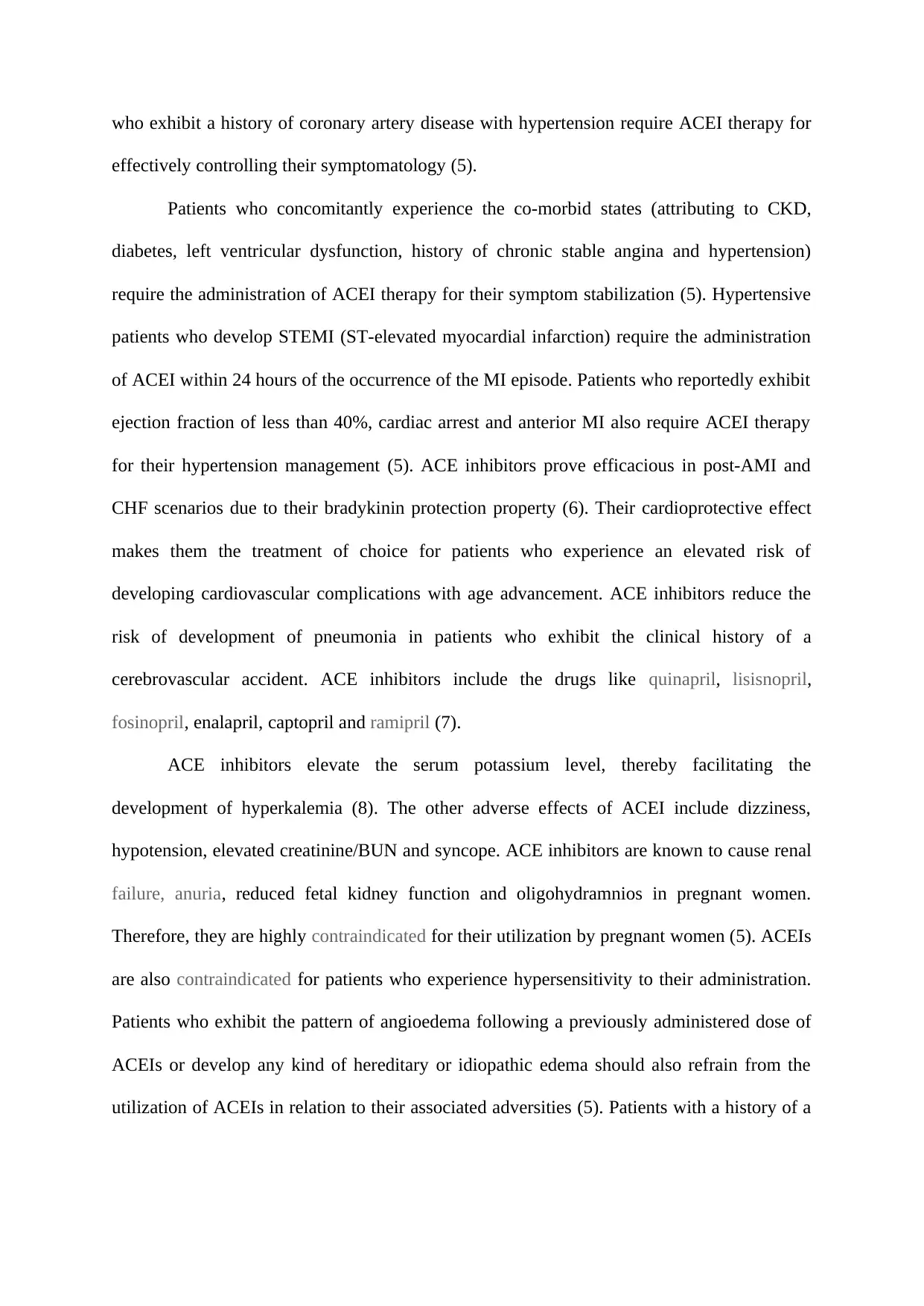
who exhibit a history of coronary artery disease with hypertension require ACEI therapy for
effectively controlling their symptomatology (5).
Patients who concomitantly experience the co-morbid states (attributing to CKD,
diabetes, left ventricular dysfunction, history of chronic stable angina and hypertension)
require the administration of ACEI therapy for their symptom stabilization (5). Hypertensive
patients who develop STEMI (ST-elevated myocardial infarction) require the administration
of ACEI within 24 hours of the occurrence of the MI episode. Patients who reportedly exhibit
ejection fraction of less than 40%, cardiac arrest and anterior MI also require ACEI therapy
for their hypertension management (5). ACE inhibitors prove efficacious in post-AMI and
CHF scenarios due to their bradykinin protection property (6). Their cardioprotective effect
makes them the treatment of choice for patients who experience an elevated risk of
developing cardiovascular complications with age advancement. ACE inhibitors reduce the
risk of development of pneumonia in patients who exhibit the clinical history of a
cerebrovascular accident. ACE inhibitors include the drugs like quinapril, lisisnopril,
fosinopril, enalapril, captopril and ramipril (7).
ACE inhibitors elevate the serum potassium level, thereby facilitating the
development of hyperkalemia (8). The other adverse effects of ACEI include dizziness,
hypotension, elevated creatinine/BUN and syncope. ACE inhibitors are known to cause renal
failure, anuria, reduced fetal kidney function and oligohydramnios in pregnant women.
Therefore, they are highly contraindicated for their utilization by pregnant women (5). ACEIs
are also contraindicated for patients who experience hypersensitivity to their administration.
Patients who exhibit the pattern of angioedema following a previously administered dose of
ACEIs or develop any kind of hereditary or idiopathic edema should also refrain from the
utilization of ACEIs in relation to their associated adversities (5). Patients with a history of a
effectively controlling their symptomatology (5).
Patients who concomitantly experience the co-morbid states (attributing to CKD,
diabetes, left ventricular dysfunction, history of chronic stable angina and hypertension)
require the administration of ACEI therapy for their symptom stabilization (5). Hypertensive
patients who develop STEMI (ST-elevated myocardial infarction) require the administration
of ACEI within 24 hours of the occurrence of the MI episode. Patients who reportedly exhibit
ejection fraction of less than 40%, cardiac arrest and anterior MI also require ACEI therapy
for their hypertension management (5). ACE inhibitors prove efficacious in post-AMI and
CHF scenarios due to their bradykinin protection property (6). Their cardioprotective effect
makes them the treatment of choice for patients who experience an elevated risk of
developing cardiovascular complications with age advancement. ACE inhibitors reduce the
risk of development of pneumonia in patients who exhibit the clinical history of a
cerebrovascular accident. ACE inhibitors include the drugs like quinapril, lisisnopril,
fosinopril, enalapril, captopril and ramipril (7).
ACE inhibitors elevate the serum potassium level, thereby facilitating the
development of hyperkalemia (8). The other adverse effects of ACEI include dizziness,
hypotension, elevated creatinine/BUN and syncope. ACE inhibitors are known to cause renal
failure, anuria, reduced fetal kidney function and oligohydramnios in pregnant women.
Therefore, they are highly contraindicated for their utilization by pregnant women (5). ACEIs
are also contraindicated for patients who experience hypersensitivity to their administration.
Patients who exhibit the pattern of angioedema following a previously administered dose of
ACEIs or develop any kind of hereditary or idiopathic edema should also refrain from the
utilization of ACEIs in relation to their associated adversities (5). Patients with a history of a

pre-existing liver impairment, renal impairment or collagen vascular disease require special
medical supervision while receiving ACEI intervention in a calculated manner (5).
The calcium channel blockers (CCBs) effectively reduce the arterial contraction by
excluding the entry of calcium ions and engagement with the binding locations over the
VDCD (i.e. voltage dependent calcium channels) (9). CCBs effectively reduce the peripheral
resistance and arterial pressure. They systematically improve the coronary circulation and
myocardial oxygenation through cardiac unloading. CCBs are prevalently utilized in
controlling the systolic and diastolic blood pressure in hypertensive patients. They induce
minimal blood pressure changes in normotensive patients (9). The non-dihydropyridine (non-
DHP) and dihydopyridine (DHP) calcium channel blockers are systematically utilized with
the objective of controlling the abnormal blood pressure fluctuations (9). The dihydopyridine
CCBs exhibit high potential (due to their vascular selectiveness) for treating the pattern of
vasospastic/stable/chronic angina in hypertensive patients (9). Non- dihydropyridine CCBs
exhibit anti-arrhythmic potential for effectively controlling the pattern of paroxysmal
supraventricular tachycardia and atrial flutter (9). CCBs also decrease the quantity of
coronary lesions in patients affected with coronary atherosclerosis (9). Calcium channel
blockers are often administered with renin-angiotensin system inhibitors for obtaining the
desirable antihypertensive effects (9).
The DHP calcium channel blockers exhibit high potential in comparison to the non-
DHP calcium channel blockers. This is because of the adverse inotropic effects of the non-
DHP CCBs (10). The non-DHP CCBs effectively manage the hypertension pattern in adult
patients affected with diabetic nephropathy and chronic kidney disease. Calcium channel
blockers including nifedipine and nicardipine effectively control hypertension because of
their rapid vasodilation and limited action of duration (10). Drugs like efonidipine and
benidipine also exhibit anti-hypertensive effects in the context of the fact that these drugs
medical supervision while receiving ACEI intervention in a calculated manner (5).
The calcium channel blockers (CCBs) effectively reduce the arterial contraction by
excluding the entry of calcium ions and engagement with the binding locations over the
VDCD (i.e. voltage dependent calcium channels) (9). CCBs effectively reduce the peripheral
resistance and arterial pressure. They systematically improve the coronary circulation and
myocardial oxygenation through cardiac unloading. CCBs are prevalently utilized in
controlling the systolic and diastolic blood pressure in hypertensive patients. They induce
minimal blood pressure changes in normotensive patients (9). The non-dihydropyridine (non-
DHP) and dihydopyridine (DHP) calcium channel blockers are systematically utilized with
the objective of controlling the abnormal blood pressure fluctuations (9). The dihydopyridine
CCBs exhibit high potential (due to their vascular selectiveness) for treating the pattern of
vasospastic/stable/chronic angina in hypertensive patients (9). Non- dihydropyridine CCBs
exhibit anti-arrhythmic potential for effectively controlling the pattern of paroxysmal
supraventricular tachycardia and atrial flutter (9). CCBs also decrease the quantity of
coronary lesions in patients affected with coronary atherosclerosis (9). Calcium channel
blockers are often administered with renin-angiotensin system inhibitors for obtaining the
desirable antihypertensive effects (9).
The DHP calcium channel blockers exhibit high potential in comparison to the non-
DHP calcium channel blockers. This is because of the adverse inotropic effects of the non-
DHP CCBs (10). The non-DHP CCBs effectively manage the hypertension pattern in adult
patients affected with diabetic nephropathy and chronic kidney disease. Calcium channel
blockers including nifedipine and nicardipine effectively control hypertension because of
their rapid vasodilation and limited action of duration (10). Drugs like efonidipine and
benidipine also exhibit anti-hypertensive effects in the context of the fact that these drugs
Secure Best Marks with AI Grader
Need help grading? Try our AI Grader for instant feedback on your assignments.
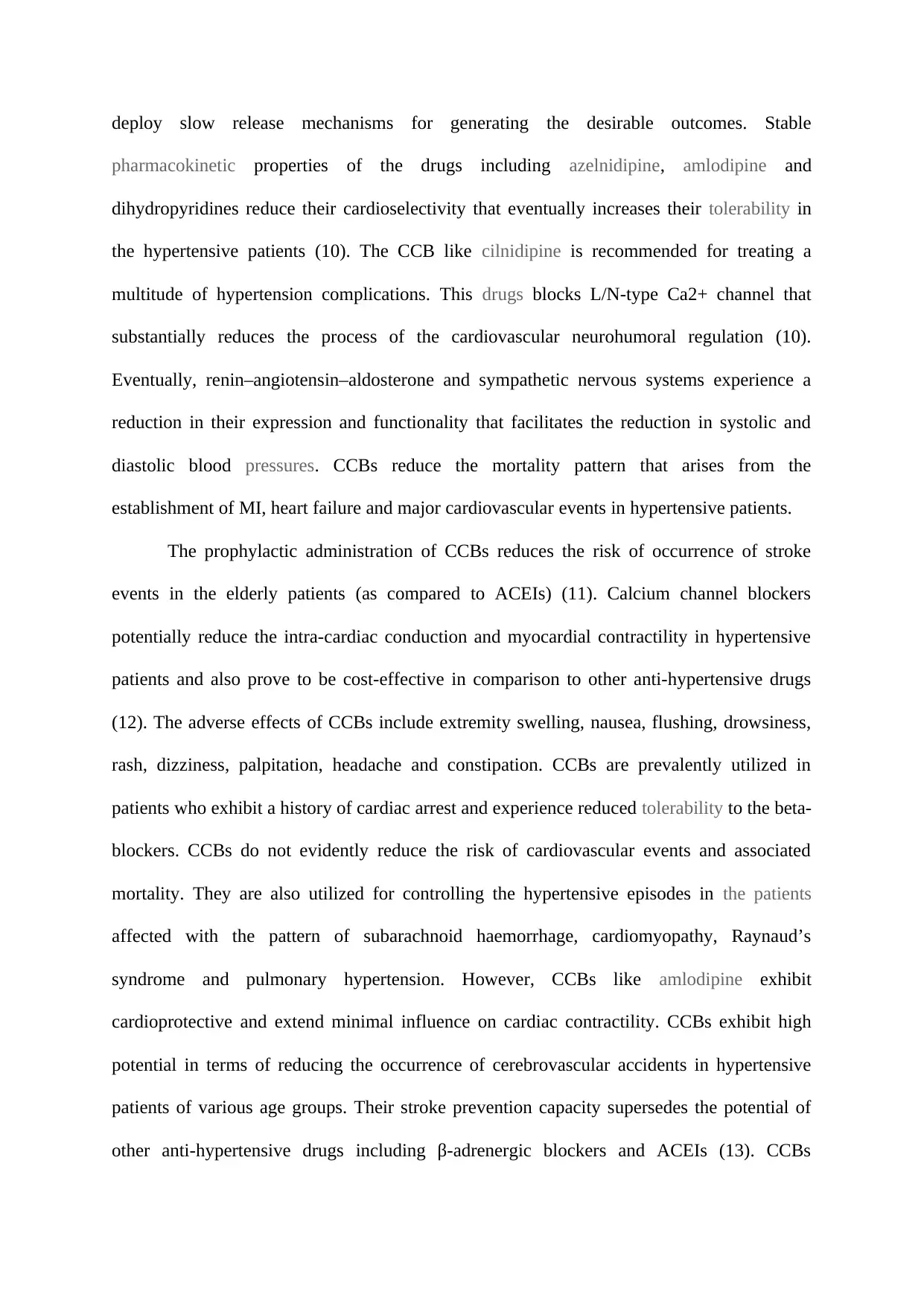
deploy slow release mechanisms for generating the desirable outcomes. Stable
pharmacokinetic properties of the drugs including azelnidipine, amlodipine and
dihydropyridines reduce their cardioselectivity that eventually increases their tolerability in
the hypertensive patients (10). The CCB like cilnidipine is recommended for treating a
multitude of hypertension complications. This drugs blocks L/N-type Ca2+ channel that
substantially reduces the process of the cardiovascular neurohumoral regulation (10).
Eventually, renin–angiotensin–aldosterone and sympathetic nervous systems experience a
reduction in their expression and functionality that facilitates the reduction in systolic and
diastolic blood pressures. CCBs reduce the mortality pattern that arises from the
establishment of MI, heart failure and major cardiovascular events in hypertensive patients.
The prophylactic administration of CCBs reduces the risk of occurrence of stroke
events in the elderly patients (as compared to ACEIs) (11). Calcium channel blockers
potentially reduce the intra-cardiac conduction and myocardial contractility in hypertensive
patients and also prove to be cost-effective in comparison to other anti-hypertensive drugs
(12). The adverse effects of CCBs include extremity swelling, nausea, flushing, drowsiness,
rash, dizziness, palpitation, headache and constipation. CCBs are prevalently utilized in
patients who exhibit a history of cardiac arrest and experience reduced tolerability to the beta-
blockers. CCBs do not evidently reduce the risk of cardiovascular events and associated
mortality. They are also utilized for controlling the hypertensive episodes in the patients
affected with the pattern of subarachnoid haemorrhage, cardiomyopathy, Raynaud’s
syndrome and pulmonary hypertension. However, CCBs like amlodipine exhibit
cardioprotective and extend minimal influence on cardiac contractility. CCBs exhibit high
potential in terms of reducing the occurrence of cerebrovascular accidents in hypertensive
patients of various age groups. Their stroke prevention capacity supersedes the potential of
other anti-hypertensive drugs including β-adrenergic blockers and ACEIs (13). CCBs
pharmacokinetic properties of the drugs including azelnidipine, amlodipine and
dihydropyridines reduce their cardioselectivity that eventually increases their tolerability in
the hypertensive patients (10). The CCB like cilnidipine is recommended for treating a
multitude of hypertension complications. This drugs blocks L/N-type Ca2+ channel that
substantially reduces the process of the cardiovascular neurohumoral regulation (10).
Eventually, renin–angiotensin–aldosterone and sympathetic nervous systems experience a
reduction in their expression and functionality that facilitates the reduction in systolic and
diastolic blood pressures. CCBs reduce the mortality pattern that arises from the
establishment of MI, heart failure and major cardiovascular events in hypertensive patients.
The prophylactic administration of CCBs reduces the risk of occurrence of stroke
events in the elderly patients (as compared to ACEIs) (11). Calcium channel blockers
potentially reduce the intra-cardiac conduction and myocardial contractility in hypertensive
patients and also prove to be cost-effective in comparison to other anti-hypertensive drugs
(12). The adverse effects of CCBs include extremity swelling, nausea, flushing, drowsiness,
rash, dizziness, palpitation, headache and constipation. CCBs are prevalently utilized in
patients who exhibit a history of cardiac arrest and experience reduced tolerability to the beta-
blockers. CCBs do not evidently reduce the risk of cardiovascular events and associated
mortality. They are also utilized for controlling the hypertensive episodes in the patients
affected with the pattern of subarachnoid haemorrhage, cardiomyopathy, Raynaud’s
syndrome and pulmonary hypertension. However, CCBs like amlodipine exhibit
cardioprotective and extend minimal influence on cardiac contractility. CCBs exhibit high
potential in terms of reducing the occurrence of cerebrovascular accidents in hypertensive
patients of various age groups. Their stroke prevention capacity supersedes the potential of
other anti-hypertensive drugs including β-adrenergic blockers and ACEIs (13). CCBs
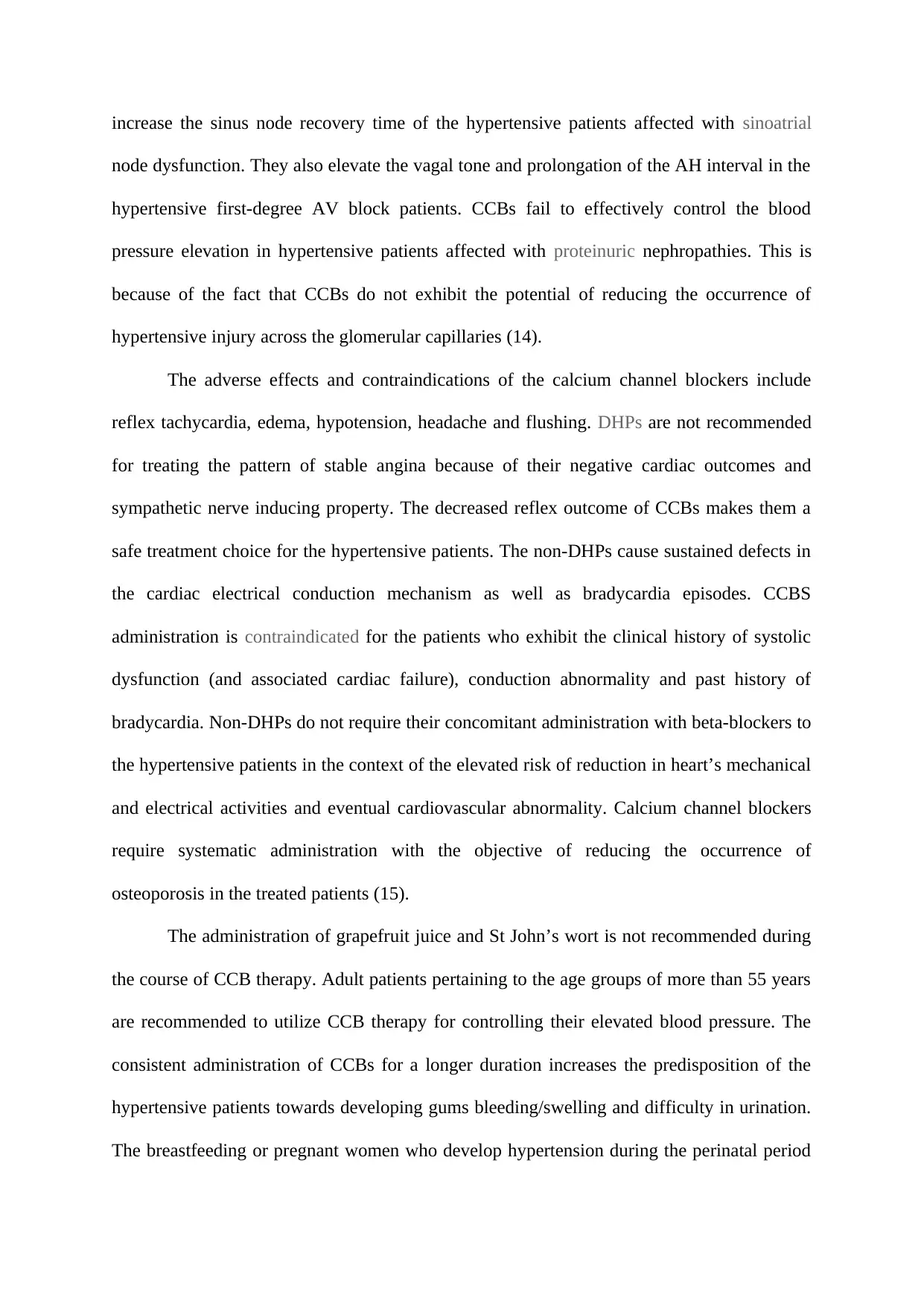
increase the sinus node recovery time of the hypertensive patients affected with sinoatrial
node dysfunction. They also elevate the vagal tone and prolongation of the AH interval in the
hypertensive first-degree AV block patients. CCBs fail to effectively control the blood
pressure elevation in hypertensive patients affected with proteinuric nephropathies. This is
because of the fact that CCBs do not exhibit the potential of reducing the occurrence of
hypertensive injury across the glomerular capillaries (14).
The adverse effects and contraindications of the calcium channel blockers include
reflex tachycardia, edema, hypotension, headache and flushing. DHPs are not recommended
for treating the pattern of stable angina because of their negative cardiac outcomes and
sympathetic nerve inducing property. The decreased reflex outcome of CCBs makes them a
safe treatment choice for the hypertensive patients. The non-DHPs cause sustained defects in
the cardiac electrical conduction mechanism as well as bradycardia episodes. CCBS
administration is contraindicated for the patients who exhibit the clinical history of systolic
dysfunction (and associated cardiac failure), conduction abnormality and past history of
bradycardia. Non-DHPs do not require their concomitant administration with beta-blockers to
the hypertensive patients in the context of the elevated risk of reduction in heart’s mechanical
and electrical activities and eventual cardiovascular abnormality. Calcium channel blockers
require systematic administration with the objective of reducing the occurrence of
osteoporosis in the treated patients (15).
The administration of grapefruit juice and St John’s wort is not recommended during
the course of CCB therapy. Adult patients pertaining to the age groups of more than 55 years
are recommended to utilize CCB therapy for controlling their elevated blood pressure. The
consistent administration of CCBs for a longer duration increases the predisposition of the
hypertensive patients towards developing gums bleeding/swelling and difficulty in urination.
The breastfeeding or pregnant women who develop hypertension during the perinatal period
node dysfunction. They also elevate the vagal tone and prolongation of the AH interval in the
hypertensive first-degree AV block patients. CCBs fail to effectively control the blood
pressure elevation in hypertensive patients affected with proteinuric nephropathies. This is
because of the fact that CCBs do not exhibit the potential of reducing the occurrence of
hypertensive injury across the glomerular capillaries (14).
The adverse effects and contraindications of the calcium channel blockers include
reflex tachycardia, edema, hypotension, headache and flushing. DHPs are not recommended
for treating the pattern of stable angina because of their negative cardiac outcomes and
sympathetic nerve inducing property. The decreased reflex outcome of CCBs makes them a
safe treatment choice for the hypertensive patients. The non-DHPs cause sustained defects in
the cardiac electrical conduction mechanism as well as bradycardia episodes. CCBS
administration is contraindicated for the patients who exhibit the clinical history of systolic
dysfunction (and associated cardiac failure), conduction abnormality and past history of
bradycardia. Non-DHPs do not require their concomitant administration with beta-blockers to
the hypertensive patients in the context of the elevated risk of reduction in heart’s mechanical
and electrical activities and eventual cardiovascular abnormality. Calcium channel blockers
require systematic administration with the objective of reducing the occurrence of
osteoporosis in the treated patients (15).
The administration of grapefruit juice and St John’s wort is not recommended during
the course of CCB therapy. Adult patients pertaining to the age groups of more than 55 years
are recommended to utilize CCB therapy for controlling their elevated blood pressure. The
consistent administration of CCBs for a longer duration increases the predisposition of the
hypertensive patients towards developing gums bleeding/swelling and difficulty in urination.
The breastfeeding or pregnant women who develop hypertension during the perinatal period
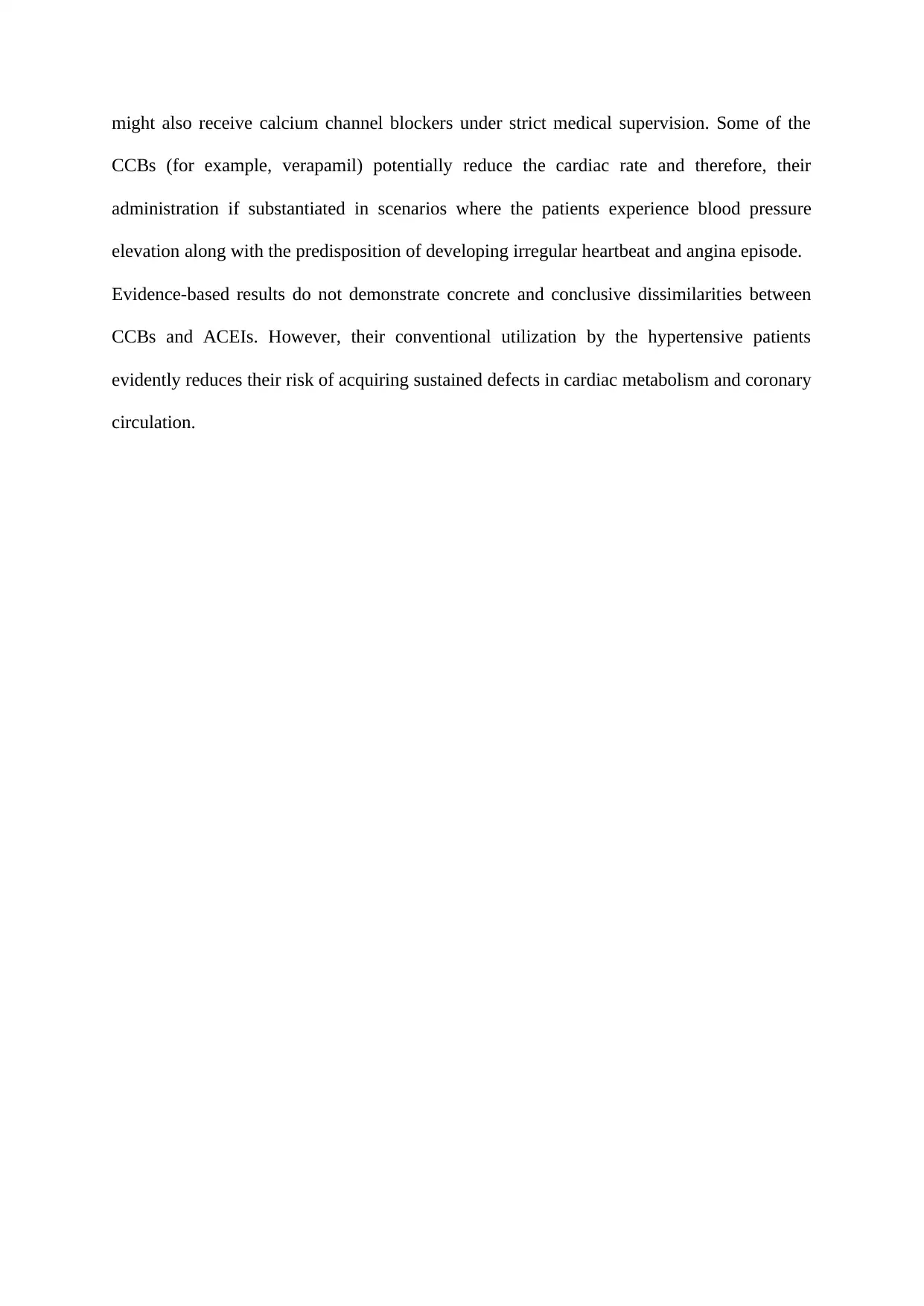
might also receive calcium channel blockers under strict medical supervision. Some of the
CCBs (for example, verapamil) potentially reduce the cardiac rate and therefore, their
administration if substantiated in scenarios where the patients experience blood pressure
elevation along with the predisposition of developing irregular heartbeat and angina episode.
Evidence-based results do not demonstrate concrete and conclusive dissimilarities between
CCBs and ACEIs. However, their conventional utilization by the hypertensive patients
evidently reduces their risk of acquiring sustained defects in cardiac metabolism and coronary
circulation.
CCBs (for example, verapamil) potentially reduce the cardiac rate and therefore, their
administration if substantiated in scenarios where the patients experience blood pressure
elevation along with the predisposition of developing irregular heartbeat and angina episode.
Evidence-based results do not demonstrate concrete and conclusive dissimilarities between
CCBs and ACEIs. However, their conventional utilization by the hypertensive patients
evidently reduces their risk of acquiring sustained defects in cardiac metabolism and coronary
circulation.
Paraphrase This Document
Need a fresh take? Get an instant paraphrase of this document with our AI Paraphraser
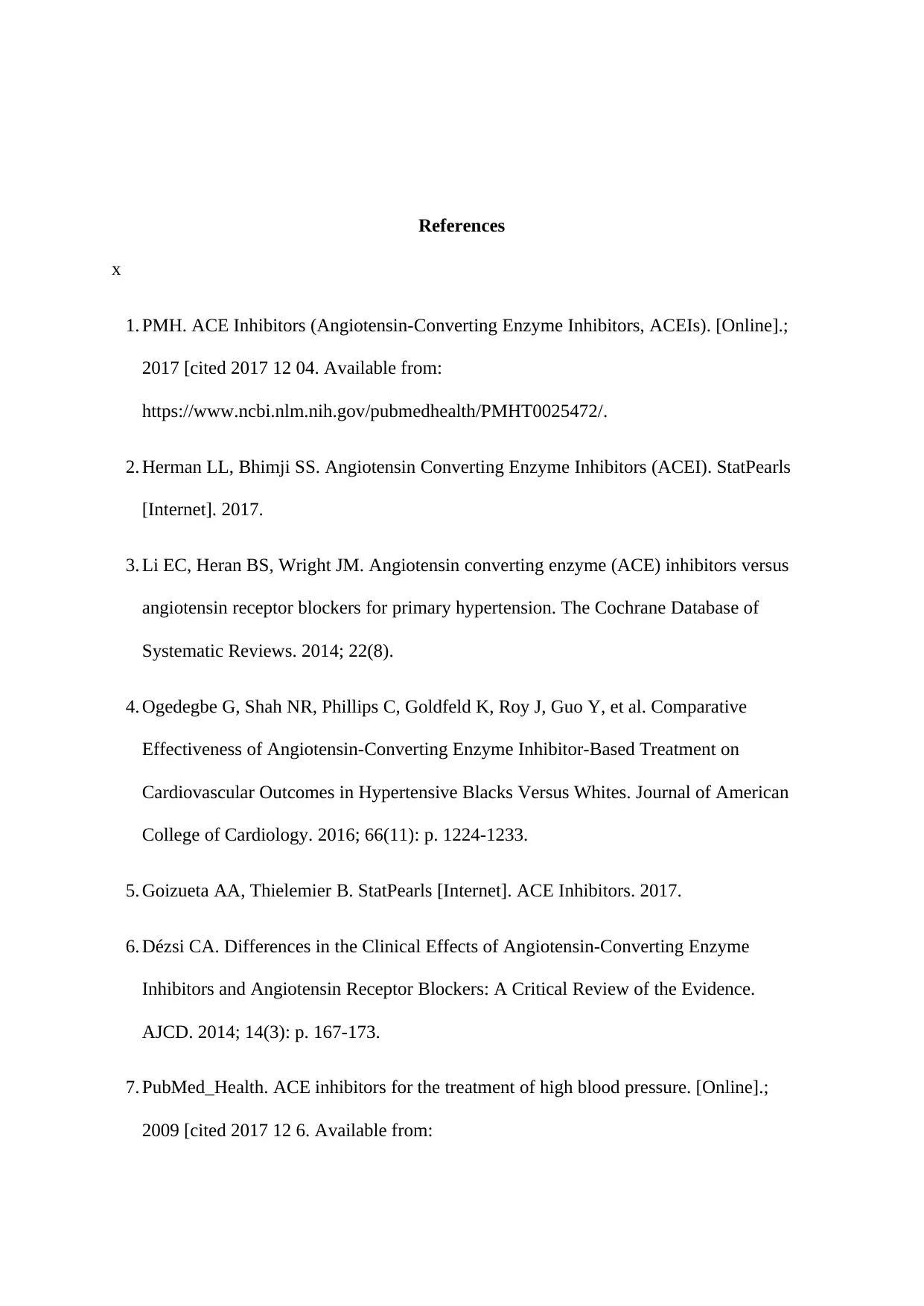
References
x
1. PMH. ACE Inhibitors (Angiotensin-Converting Enzyme Inhibitors, ACEIs). [Online].;
2017 [cited 2017 12 04. Available from:
https://www.ncbi.nlm.nih.gov/pubmedhealth/PMHT0025472/.
2. Herman LL, Bhimji SS. Angiotensin Converting Enzyme Inhibitors (ACEI). StatPearls
[Internet]. 2017.
3. Li EC, Heran BS, Wright JM. Angiotensin converting enzyme (ACE) inhibitors versus
angiotensin receptor blockers for primary hypertension. The Cochrane Database of
Systematic Reviews. 2014; 22(8).
4. Ogedegbe G, Shah NR, Phillips C, Goldfeld K, Roy J, Guo Y, et al. Comparative
Effectiveness of Angiotensin-Converting Enzyme Inhibitor-Based Treatment on
Cardiovascular Outcomes in Hypertensive Blacks Versus Whites. Journal of American
College of Cardiology. 2016; 66(11): p. 1224-1233.
5. Goizueta AA, Thielemier B. StatPearls [Internet]. ACE Inhibitors. 2017.
6. Dézsi CA. Differences in the Clinical Effects of Angiotensin-Converting Enzyme
Inhibitors and Angiotensin Receptor Blockers: A Critical Review of the Evidence.
AJCD. 2014; 14(3): p. 167-173.
7. PubMed_Health. ACE inhibitors for the treatment of high blood pressure. [Online].;
2009 [cited 2017 12 6. Available from:
x
1. PMH. ACE Inhibitors (Angiotensin-Converting Enzyme Inhibitors, ACEIs). [Online].;
2017 [cited 2017 12 04. Available from:
https://www.ncbi.nlm.nih.gov/pubmedhealth/PMHT0025472/.
2. Herman LL, Bhimji SS. Angiotensin Converting Enzyme Inhibitors (ACEI). StatPearls
[Internet]. 2017.
3. Li EC, Heran BS, Wright JM. Angiotensin converting enzyme (ACE) inhibitors versus
angiotensin receptor blockers for primary hypertension. The Cochrane Database of
Systematic Reviews. 2014; 22(8).
4. Ogedegbe G, Shah NR, Phillips C, Goldfeld K, Roy J, Guo Y, et al. Comparative
Effectiveness of Angiotensin-Converting Enzyme Inhibitor-Based Treatment on
Cardiovascular Outcomes in Hypertensive Blacks Versus Whites. Journal of American
College of Cardiology. 2016; 66(11): p. 1224-1233.
5. Goizueta AA, Thielemier B. StatPearls [Internet]. ACE Inhibitors. 2017.
6. Dézsi CA. Differences in the Clinical Effects of Angiotensin-Converting Enzyme
Inhibitors and Angiotensin Receptor Blockers: A Critical Review of the Evidence.
AJCD. 2014; 14(3): p. 167-173.
7. PubMed_Health. ACE inhibitors for the treatment of high blood pressure. [Online].;
2009 [cited 2017 12 6. Available from:
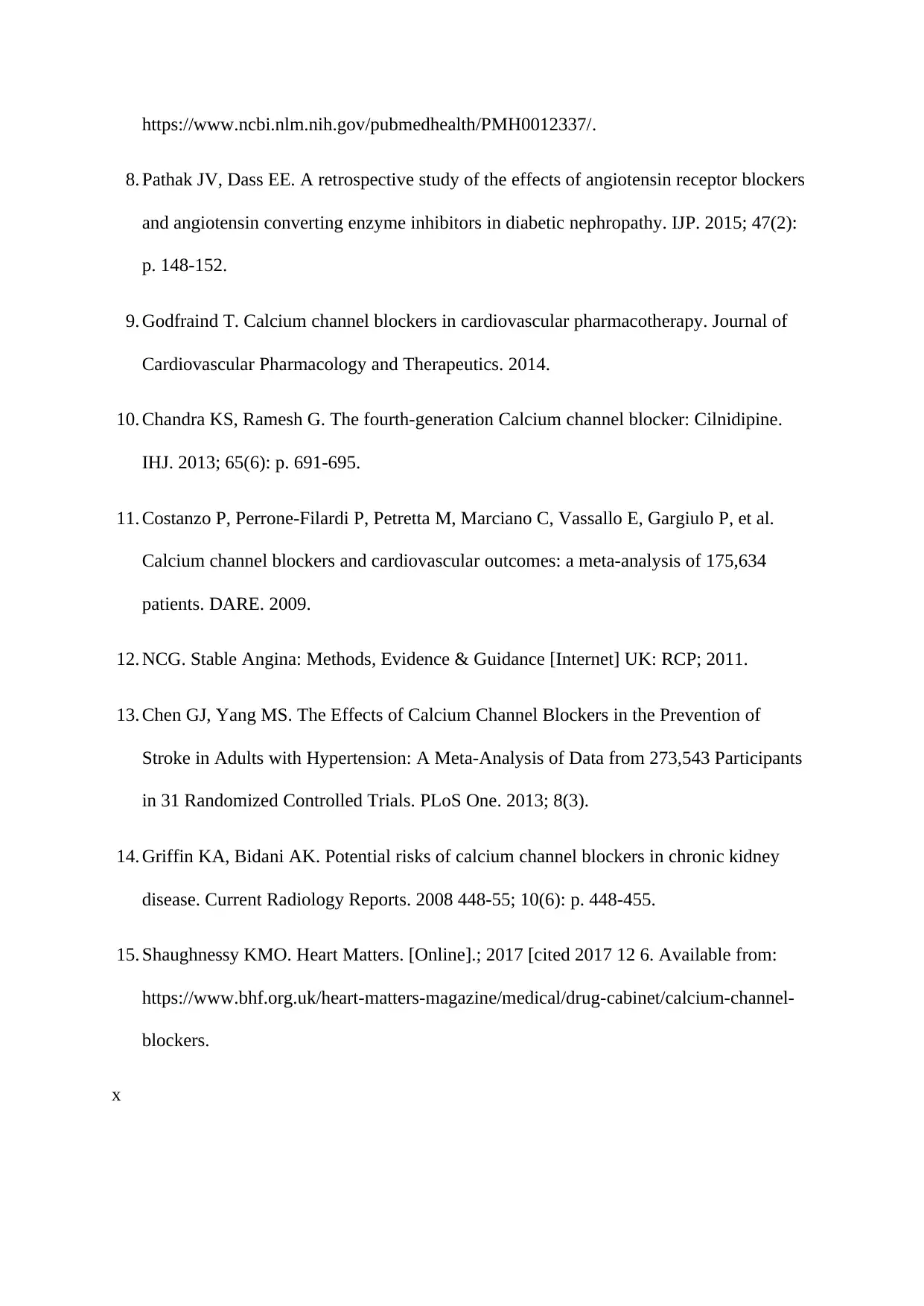
https://www.ncbi.nlm.nih.gov/pubmedhealth/PMH0012337/.
8. Pathak JV, Dass EE. A retrospective study of the effects of angiotensin receptor blockers
and angiotensin converting enzyme inhibitors in diabetic nephropathy. IJP. 2015; 47(2):
p. 148-152.
9. Godfraind T. Calcium channel blockers in cardiovascular pharmacotherapy. Journal of
Cardiovascular Pharmacology and Therapeutics. 2014.
10. Chandra KS, Ramesh G. The fourth-generation Calcium channel blocker: Cilnidipine.
IHJ. 2013; 65(6): p. 691-695.
11. Costanzo P, Perrone-Filardi P, Petretta M, Marciano C, Vassallo E, Gargiulo P, et al.
Calcium channel blockers and cardiovascular outcomes: a meta-analysis of 175,634
patients. DARE. 2009.
12. NCG. Stable Angina: Methods, Evidence & Guidance [Internet] UK: RCP; 2011.
13. Chen GJ, Yang MS. The Effects of Calcium Channel Blockers in the Prevention of
Stroke in Adults with Hypertension: A Meta-Analysis of Data from 273,543 Participants
in 31 Randomized Controlled Trials. PLoS One. 2013; 8(3).
14. Griffin KA, Bidani AK. Potential risks of calcium channel blockers in chronic kidney
disease. Current Radiology Reports. 2008 448-55; 10(6): p. 448-455.
15. Shaughnessy KMO. Heart Matters. [Online].; 2017 [cited 2017 12 6. Available from:
https://www.bhf.org.uk/heart-matters-magazine/medical/drug-cabinet/calcium-channel-
blockers.
x
8. Pathak JV, Dass EE. A retrospective study of the effects of angiotensin receptor blockers
and angiotensin converting enzyme inhibitors in diabetic nephropathy. IJP. 2015; 47(2):
p. 148-152.
9. Godfraind T. Calcium channel blockers in cardiovascular pharmacotherapy. Journal of
Cardiovascular Pharmacology and Therapeutics. 2014.
10. Chandra KS, Ramesh G. The fourth-generation Calcium channel blocker: Cilnidipine.
IHJ. 2013; 65(6): p. 691-695.
11. Costanzo P, Perrone-Filardi P, Petretta M, Marciano C, Vassallo E, Gargiulo P, et al.
Calcium channel blockers and cardiovascular outcomes: a meta-analysis of 175,634
patients. DARE. 2009.
12. NCG. Stable Angina: Methods, Evidence & Guidance [Internet] UK: RCP; 2011.
13. Chen GJ, Yang MS. The Effects of Calcium Channel Blockers in the Prevention of
Stroke in Adults with Hypertension: A Meta-Analysis of Data from 273,543 Participants
in 31 Randomized Controlled Trials. PLoS One. 2013; 8(3).
14. Griffin KA, Bidani AK. Potential risks of calcium channel blockers in chronic kidney
disease. Current Radiology Reports. 2008 448-55; 10(6): p. 448-455.
15. Shaughnessy KMO. Heart Matters. [Online].; 2017 [cited 2017 12 6. Available from:
https://www.bhf.org.uk/heart-matters-magazine/medical/drug-cabinet/calcium-channel-
blockers.
x
1 out of 9
Related Documents
Your All-in-One AI-Powered Toolkit for Academic Success.
+13062052269
info@desklib.com
Available 24*7 on WhatsApp / Email
![[object Object]](/_next/static/media/star-bottom.7253800d.svg)
Unlock your academic potential
© 2024 | Zucol Services PVT LTD | All rights reserved.





